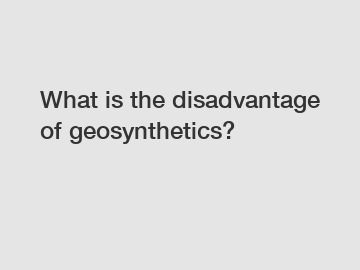What is the disadvantage of geosynthetics?
Geosynthetics are synthetic materials used in various civil engineering applications such as landscaping, erosion control, drainage, and road construction. They offer several advantages such as cost-effectiveness, durability, and flexibility. However, like any other construction material, geosynthetics also have their disadvantages. In this article, we will explore the disadvantages of geosynthetics and how they can affect construction projects.
**Durability**.
One of the main disadvantages of geosynthetics is their durability. While geosynthetics are designed to withstand harsh environmental conditions, they can degrade over time due to exposure to UV rays, chemicals, and extreme temperatures. This can lead to a reduction in their effectiveness and longevity, resulting in the need for frequent maintenance or replacement. In some cases, the degradation of geosynthetics can compromise the stability and performance of the entire construction project.

**Compatibility with Soils**.
Another disadvantage of geosynthetics is their compatibility with different types of soils. Geosynthetics are often used to enhance the strength and stability of soil, but they may not be suitable for all soil types. In some cases, geosynthetics can interfere with the natural behavior of soil, leading to undesirable outcomes such as reduced drainage, increased erosion, or even structural failure. It is important to carefully consider the characteristics of the soil and the specific requirements of the project before selecting geosynthetics for use.
**Installation Challenges**.
Geosynthetics can be challenging to install properly, especially in large-scale construction projects. Improper installation can result in wrinkles, folds, or gaps in the geosynthetic material, which can compromise its effectiveness and longevity. Moreover, the installation of geosynthetics requires specialized equipment and trained personnel, which can increase the overall cost of the project. In some cases, errors in installation can lead to delays in construction or even pose safety risks to workers on-site.
**Environmental Concerns**.
Geosynthetics are often made from synthetic materials such as polypropylene or polyester, which are derived from non-renewable resources. The production, use, and disposal of geosynthetics can have a negative impact on the environment, including pollution, greenhouse gas emissions, and waste generation. Additionally, the degradation of geosynthetics over time can release harmful chemicals into the soil and water, posing risks to ecosystems and human health. As sustainability becomes a more significant consideration in construction projects, the environmental impact of geosynthetics is becoming a growing concern.
**Cost**.
While geosynthetics are generally considered to be cost-effective compared to traditional construction materials, they can still represent a significant portion of the overall project budget. The initial cost of geosynthetics, along with the expenses associated with installation, maintenance, and disposal, can add up quickly. In some cases, the total cost of using geosynthetics may be higher than expected, especially if additional measures are required to mitigate the disadvantages mentioned above. It is essential for project planners to carefully assess the long-term costs of using geosynthetics and consider alternative solutions if necessary.
In conclusion, while geosynthetics offer many benefits in construction projects, they also come with their disadvantages. It is crucial for project planners, engineers, and contractors to be aware of these disadvantages and take appropriate measures to mitigate risks and ensure successful project outcomes. By carefully considering factors such as durability, compatibility with soils, installation challenges, environmental concerns, and cost, it is possible to maximize the advantages of geosynthetics while minimizing their disadvantages.
If you have any questions or would like to learn more about geosynthetics, please feel free to contact us.
If you want to learn more, please visit our website trp geomembranes company, geocomposite exporter, geosynthetic clay liner supplier.

Comments